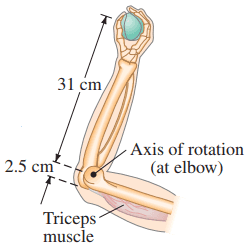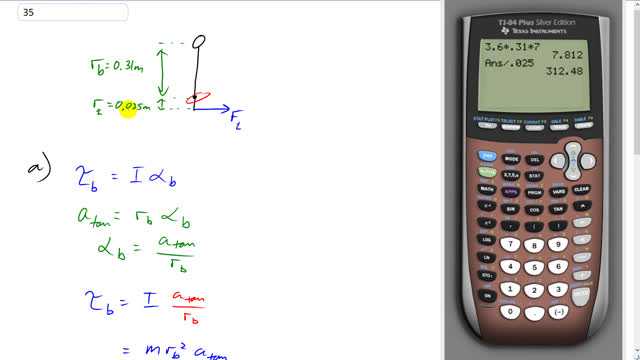
The forearm in Fig. 8–46 accelerates a 3.6-kg ball at by means of the triceps muscle, as shown. Calculate
- the torque needed, and
- the force that must be exerted by the triceps muscle. Ignore the mass of the arm.


In order to watch this solution you need to have a subscription.
This is Giancoli Answers with Mr. Dychko. The tricep is applying a force to the right on this elbow joint—and here's the elbow here— and has some lever arm away from the elbow pivot equal to 0.025 meters, converting those centimeters into meters, and the ball and the hand is up here at a distance 0.31 meters away from the elbow and the first job is to figure out what torque is required to accelerate this ball at 7 meters per second squared. So the torque on the ball is its moment of inertia times its angular acceleration and the tangental acceleration which we are given is equal to the radius of the ball's path times its angular acceleration and we'll divide both sides by r b— radius of the ball— and then that gives α b equals ball's tangental acceleration divided by its radius—distance from the pivot— and then we'll substitute that in for α b here to get the torque on the ball: moment of inertia times a tangent over r b. So the moment of inertia for a point mass which we assume this ball is and we are ignoring the mass of the forearm is gonna be the mass of the ball times its distance from the pivot squared and one of these r b's cancel here giving us this formula for the torque on the ball: mass times its distance from the elbow times the tangental acceleration. So that's 3.6 kilograms times 0.31 meters times 7 meters per second squared which is 7.8 newton meters. So the torque produced by the tricep is equal to this torque that's on the ball and the torque produced by the tricep is the force exerted by the tricep times its distance from the elbow. So we can solve this for the force by dividing both sides by r t and we get the force of the tricep is 7.812 newton meters divided by 0.025 meters which is 310 newtons when you round it to two significant figures.